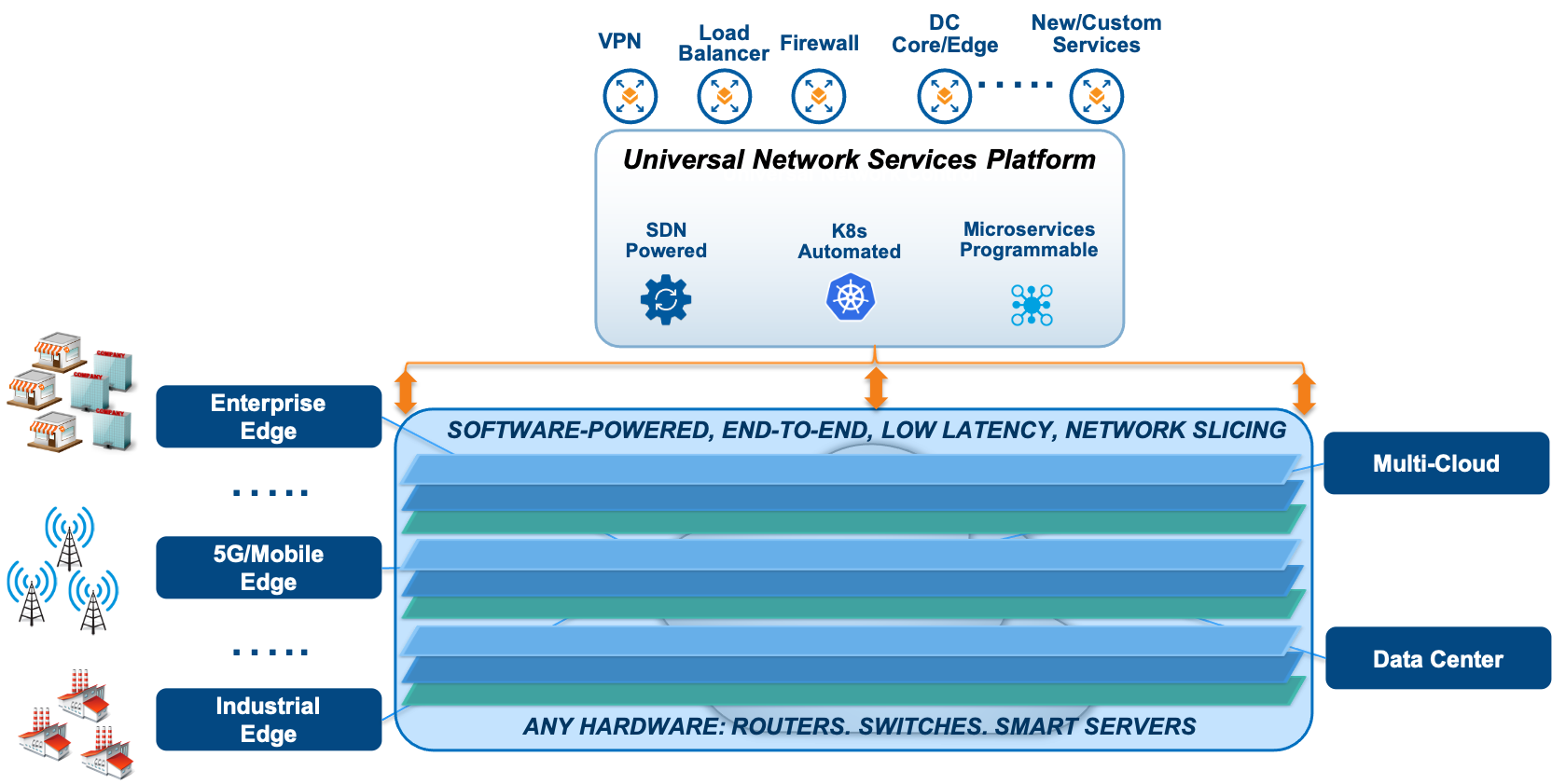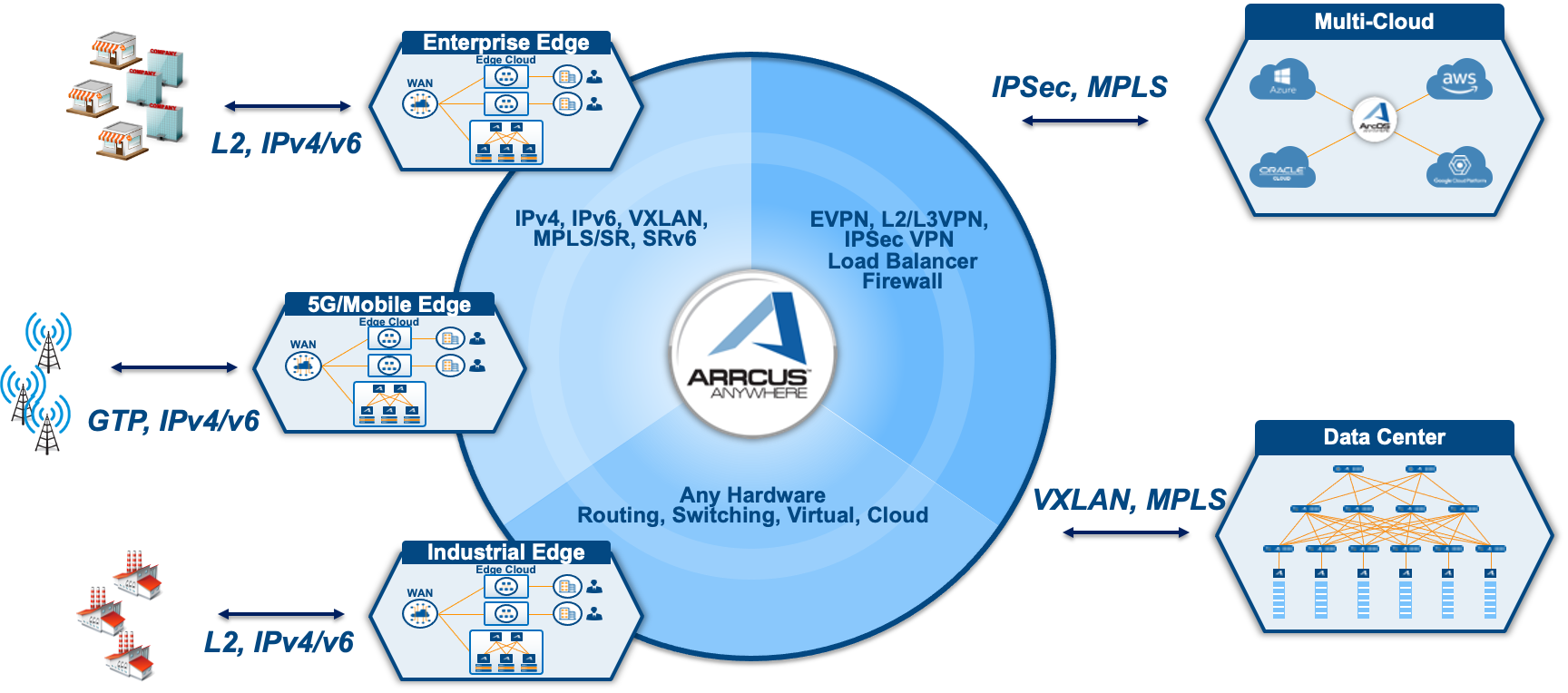
We are in the midst of numerous foundational technological shifts in communications infrastructure that represents a generational opportunity for consumers, businesses, and providers alike.
By 2023, it is estimated that there will be approximately 5.3 billion Internet users, 30 billion networked devices, 15 billion M2M (machine to machine) connections, and 100 exabytes per month of mobile data traffic. Video is expected to drive around 82 percent of the traffic and the subscriber bandwidth expected to grow by 30 percent. This, coupled with the application-rich consumer market, is driving the 5G upgrade cycle, the adoption of new delivery paradigms, and business opportunities that include fixed wireless access, V2X (Vehicle to Everything), mobile internet, mobility and voice, and Robotics/VR.
Meanwhile, edge computing innovations are enabling drastically lower latencies, better response times, and massively improving business continuity by moving micro-data centers closer to the origin of the data instead of at the legacy centralized datacenter silos. Microsoft’s recent acquisition of Affirmed Networks for around $1.35 billion affirms the strategic opportunity supported by this trend. The global pandemic and working from home have only accelerated this trend. IDC predicts that, by 2023, over 50 percent of new enterprise IT infrastructure deployed will be at the edge and the edge access market is expected to drive around $50 billion in revenues by 2027. Businesses now can consume services in new ways for various use cases at the Industrial Edge, the Enterprise Edge, the Mobile/Telco Edge, the Retail Edge, and the CDN Edge.
The Network is the Service Enabler
To interconnect such a hyper-distributed environment spanning the traditional on-prem data centers, multi-clouds, and the emerging edge, the network must evolve rapidly and become more cloud-like: agile (software-powered network services), elastic (on-demand scale-up and scale-down), and cognitive (AI/ML powered analytics).
Communication Service Providers are already re-designing their network infrastructure and ramping up their spending to support these requirements. In fact, according to a new report, by 2025 operators will spend up to $114 billion on network cloudification. Most of this investment is going towards adopting modern frameworks that are cloud-native, software-powered, AIOps enabled, with innovative open network technologies such as segment routing, EVPN, network slicing, programmable data planes, Kubernetes-powered automated application orchestration, and OpenConfig/YANG-based programmatic interfaces.
Such a software-powered, intelligent network abstracts the underlying merchant silicon-based white box hardware across the entire spectrum of routers, switches, and smart servers with a variety of port-densities and speeds. It also enables the seamless deployment of higher-layer services such as WAF, load balancers, firewalls, DDoS protection, network interconnects, and custom services while also supporting the ever-exacting SLAs (latency, response, continuity).
There is a massive market opportunity to help businesses keep their infrastructure costs under control as they scale to support these requirements. However, until recently, they were constrained by the lack of any viable choices and ended up falling back to traditional, incumbent OEMs especially in the edge and the backbone.
A Unified, End-to-End Software-Defined Network Service
ArcOS, the microservices-based Arrcus networking operating system built from first principles, enables a singular software solution while simultaneously creating an open, consistent, and unified solution from an overall operational perspective. Arrcus delivers high-performance, massively scalable, application-centric solutions built with:
- Best-in-class network protocols (BGP, EVPN) with carrier-grade reliability
- Seamless end-to-end interoperability of a wide-variety of software overlays (physical, virtual) and encapsulations (segment routing, MPLS, VXLAN)
- Multi-service solution that leverages any merchant silicon or system hardware
- Arrcus’ ArcIQ deep visibility analytics platform
- Open standards-based APIs, popular open-source tooling ecosystem integration (Terraform, Ansible, Prometheus, Grafana)
As an example, with the introduction of the industry’s first 768 Tb/sec Arrcus Virtualized Distributed router (VDR), customers are now able to dynamically auto-scale out (with Kubernetes) containerized network services (IP/MPLS VPN, Peering, L2VPN) over a common physical router infrastructure.
In summary, the highly scalable, high performance, hardware agnostic ArcOS solution allows it to seamlessly run across any system whether it be routing, distributed routing, switching, virtual, and multi-cloud environments.
Arrcus Cloud-To-Edge Services
But that’s not all. Businesses – enterprises and CSPs alike – have a number of applications that are not latency-sensitive, will run from centralized public clouds but demand always-on secure, high performance network connectivity to the edge. This is where the Arrcus multi-cloud networking (MCN) solution comes in and delivers an IPSec based, easy-to-deploy and managed cloud connectivity solution, enabling companies to rapidly connect their data centers and global sites to their cloud or connect any-cloud to any-cloud in minutes. Built from ArcOS, it makes cloud connections easy to set up, manage and is fully encrypted for superior security.
From the edge infrastructure, you now can:
- Directly connect the various edges and bare-metal services to the cloud hub thereby avoiding unnecessary DC backhaul
- Multi-cloud transit hub support with DirectConnect and ExpressRoute links
- Support for industry standard routing protocols to ease multi-region, multi-cloud connectivity
The Power Of One
Now, let’s put these capabilities together with the example of a 5G mobile edge access solution. Mobile operators have to support massive data traffic, with low latency for the application services while not increasing the complexity of the network. In addition, they have moved towards horizontal open network platforms with a number of mobility functions (RAN, EPC) virtualized and distributed across multiple cloud (Edge, Regional, Core, Public Cloud) domains which necessitates flexibility in the optimum solutions. Multi-Access Edge Computing (MEC) instances facilitate the migration of applications and services closer to the user and enhance their experience
Arrcus offers the complete solution through:
- End-to-end EVPN routing control plane
- SRv6/SR-MPLS data plane with multiple encapsulation hand-offs to DCs, multi-clouds, and edge deployments
- Multi-cloud networking that dramatically accelerates, simplifies and secures cloud connectivity to edge sites
- Standards-based APIs interfacing with third party applications and services
The high density requirement of 5G is met through a lean, resilient and composable software, cost-effective white box hardware supporting 1G/10G/25G/100G/400G speeds, and a programmable SDN solution that holds all the intelligence and complexity thereby enabling massive scale.
This solution allows for the mobile application layer to implement Control & User Plane Separation (CUPS) much more easily. By having the user plane function (vUPF) flexibly placed at distributed edges, operators can drive lower latency while the control plane functions (vCPF) can be the point for centralized SDN-like policy.
Arrcus Is The Complete Solution: AnyService, AnyTime, AnyWhere
This is an exciting time to be disrupting the networking industry. The Arrcus approach provides a Simple, Scalable, Secure, and Seamless Solutions across the Enterprise, CSP and Multi-Cloud environments.
 The significance of this is that, uniquely, the Arrcus portfolio of capabilities provides “AnyService, AnyWhere, at AnyTime.” This allows you to leverage best-in-class software solutions, a flexible deployment model and the lowest total cost of ownership for your customers.
The significance of this is that, uniquely, the Arrcus portfolio of capabilities provides “AnyService, AnyWhere, at AnyTime.” This allows you to leverage best-in-class software solutions, a flexible deployment model and the lowest total cost of ownership for your customers.
Please visit the Arrcus website at https://www.arrcus.com/ for more information, to schedule a demo, or to just learn more about the Arrcus products and solutions.
Devesh Garg is co-founder and chief executive officer and Murali Gandluru is vice president of product management at Arrcus.
This content was sponsored by Arrcus.







Be the first to comment